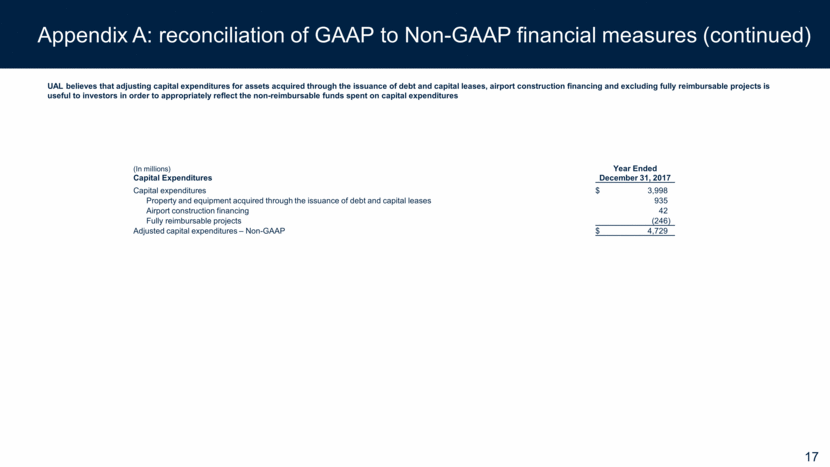Attached files
| file | filename |
|---|---|
| 8-K - 8-K - United Airlines Holdings, Inc. | a18-36218_18k.htm |
Deutsche Bank Leveraged Finance Conference October 2, 2018 Mike Leskinen Managing Director Investor Relations Ted North Managing Director Corporate Finance

Safe Harbor Statement Certain statements included in this presentation are forward-looking and thus reflect our current expectations and beliefs with respect to certain current and future events and anticipated financial and operating performance. Such forward-looking statements are and will be subject to many risks and uncertainties relating to our operations and business environment that may cause actual results to differ materially from any future results expressed or implied in such forward-looking statements. Words such as “expects,” “will,” “plans,” “anticipates,” “indicates,” “believes,” “estimates,” “forecast,” “guidance,” “outlook,” “goals” and similar expressions are intended to identify forward-looking statements. Additionally, forward-looking statements include statements that do not relate solely to historical facts, such as statements which identify uncertainties or trends, discuss the possible future effects of current known trends or uncertainties, or which indicate that the future effects of known trends or uncertainties cannot be predicted, guaranteed or assured. All forward-looking statements in this presentation are based upon information available to us on the date of this presentation. We undertake no obligation to publicly update or revise any forward-looking statement, whether as a result of new information, future events, changed circumstances or otherwise, except as required by applicable law. Our actual results could differ materially from these forward-looking statements due to numerous factors including, without limitation, the following: general economic conditions (including interest rates, foreign currency exchange rates, investment or credit market conditions, crude oil prices, costs of aircraft fuel and energy refining capacity in relevant markets); economic and political instability and other risks of doing business globally, including political developments that may impact our operations in certain countries; demand for travel and the impact that global economic and political conditions have on customer travel patterns; competitive pressures on pricing and on demand; demand for transportation in the markets in which we operate; our capacity decisions and the capacity decisions of our competitors; the effects of any hostilities, act of war or terrorist attack; the effects of any technology failures or cybersecurity breaches; the impact of regulatory, investigative and legal proceedings and legal compliance risks; disruptions to our regional network; the ability of other air carriers with whom we have alliances or partnerships to provide the services contemplated by the respective arrangements with such carriers; costs associated with any modification or termination of our aircraft orders; potential reputational or other impact from adverse events in our operations, the operations of our regional carriers or the operations of our code share partners; our ability to attract and retain customers; our ability to execute our operational plans and revenue-generating initiatives, including optimizing our revenue; our ability to control our costs, including realizing benefits from our resource optimization efforts, cost reduction initiatives and fleet replacement programs; the impact of any management changes; our ability to cost-effectively hedge against increases in the price of aircraft fuel if we decide to do so; any potential realized or unrealized gains or losses related to any fuel or currency hedging programs; labor costs; our ability to maintain satisfactory labor relations and the results of any collective bargaining agreement process with our union groups; any disruptions to operations due to any potential actions by our labor groups; an outbreak of a disease that affects travel demand or travel behavior; U.S. or foreign governmental legislation, regulation and other actions (including Open Skies agreements and environmental regulations); industry consolidation or changes in airline alliances; our ability to comply with the terms of our various financing arrangements; the costs and availability of financing; our ability to maintain adequate liquidity; the costs and availability of aviation and other insurance; weather conditions; our ability to utilize our net operating losses to offset future taxable income; the impact of changes in tax laws; the success of our investments in airlines in other parts of the world; and other risks and uncertainties set forth under Part I, Item 1A., “Risk Factors,” of our Annual Report on Form 10-K for the fiscal year ended December 31, 2017, as well as other risks and uncertainties set forth from time to time in the reports we file with the U.S. Securities and Exchange Commission.
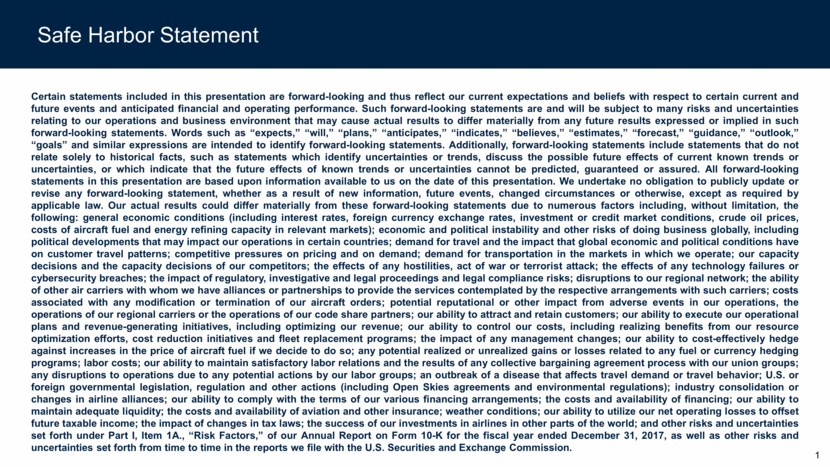
The U.S. airline industry is now generating consistent profits U.S. passenger airlines Pre-tax earnings Structural changes in the business have led to financial stability $30B $20B $10B $0B ($10B) ($20B) ($30B) 2007 2006 2005 2019 2012 2011 2010 2009 2008 2001 2000 2015 2014 2013 2018 2017 2016 2004 2003 2002 Profit/(Loss) Margin Source: U.S DOT Form 41 Data; 2018 and 2019 figures based on Wall Street consensus industry growth projections 2000-2013 averaged ~$5B annual pre-tax loss and negative (3%) pre-tax margin 2014-2019 projected to average ~$18B annual pre-tax income and ~10% pre-tax margin Profit/(Loss) Margin (25%) (20%) (15%) (10%) (5%) 0% 5% 10% 15%
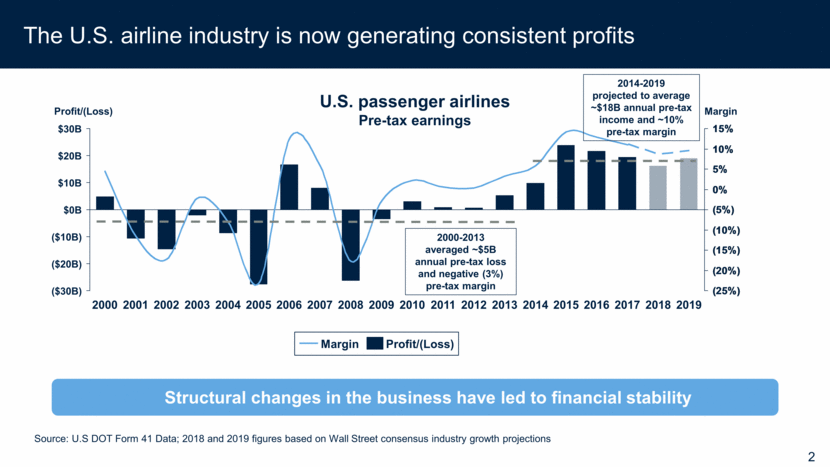
Business Highlights
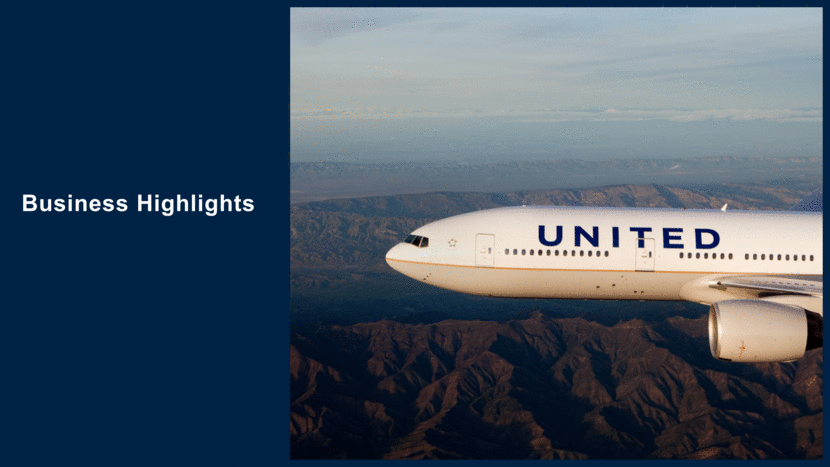
Delivering top-tier operational performance continues to be our focus D:001 1 Consolidated system flights Source: masFlight 2Q16 2Q18 2Q17 2Q18 D:001 69.8% UA 70.0% WN 46.3% AA 65.2% DL Completion factor1 2Q16 98.3% 98.7% 2Q18 2Q17 98.6% 70.0% 69.7% 68.7%
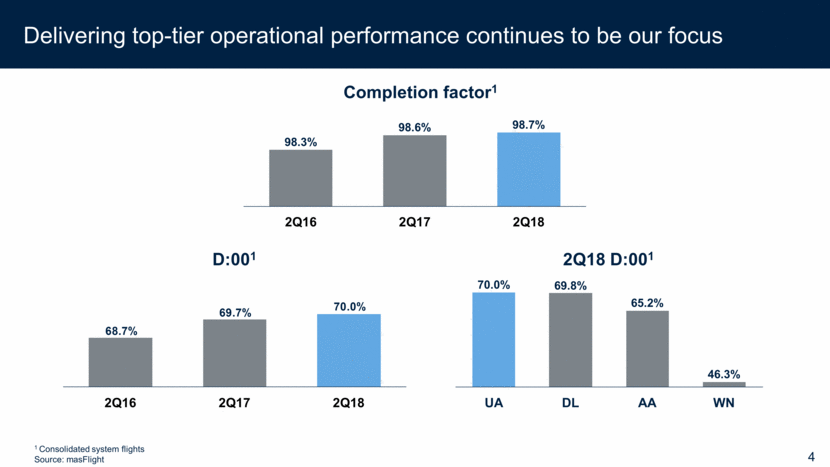
Improving customer service and experience is a top priority Equipping employees with modern tools Completed rollout of 10,000 mobile devices for airport agents in 1Q18 Continue to train our team on core4, United’s customer service hierarchical decision framework Designed to drive improved customer service and experience Key core4 principles: safe, caring, dependable, and efficient
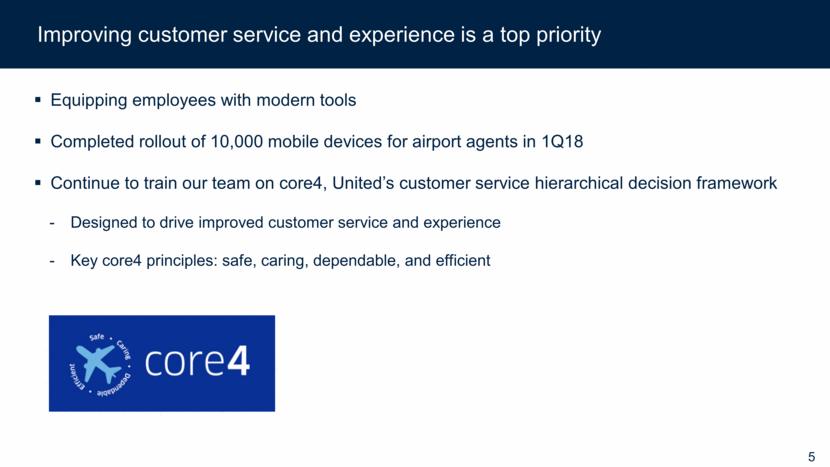
Network strategy Network is our foundation Leverage our strengths “Uniquely United” opportunities Our network has tremendous potential – capitalizing on our strengths and improving our hub quality Other commercial elements require a strong network to succeed Overall strategy returns United to profitable growth Our international gateways are a structural advantage that we will continue to grow and enhance Enhance and improve our alliances and JVs Geographic position of our hubs Grow our domestic network to strengthen our mid-continent hubs Greater scale at our hubs reinforces our relevance and value proposition to customers Continue to improve connectivity at our hubs

Fleet flexibility in the event of a downturn 109 Lease expirations 2020E 2019E 94 Aircraft late in life-cycle with heavy maintenance due Flexibility levers in mainline fleet Estimated resulting capacity reduction (~12%) (~12%) Leased aircraft can be returned to lessor at time of contract expiration Aircraft late in life-cycle and due for heavy maintenance overhauls can be retired and used for spare parts 63 66 31 43
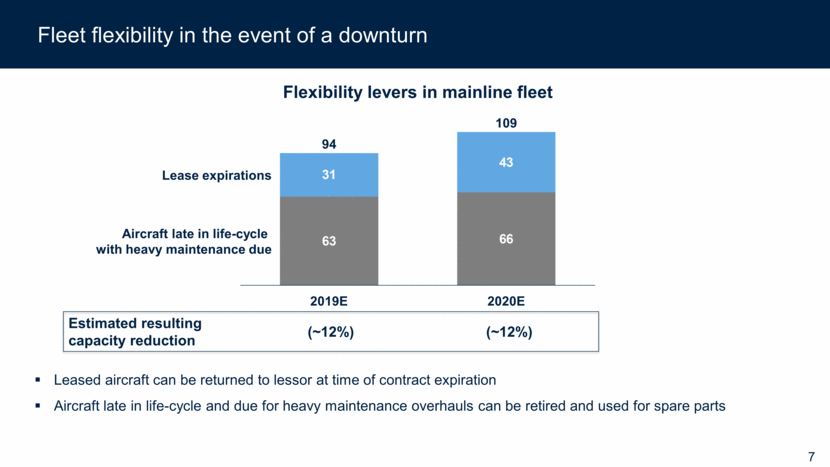
Segmentation Loyalty Revenue Management Commercial initiatives running in-line with expectations Gemini running on all flights and all cabins Results exceeded expectations in the first half of the year Rolled out Basic Economy in select Latin markets Launched a Basic Economy-like product across the Atlantic Launched a new United Explorer card in June New card acquisitions grew over 10% year-over-year in 2Q Rebanking Strong 2Q results following our rebank initiatives in Houston and Chicago Revenue to small cities from large/medium cities up over 10% year-over-year in 2Q
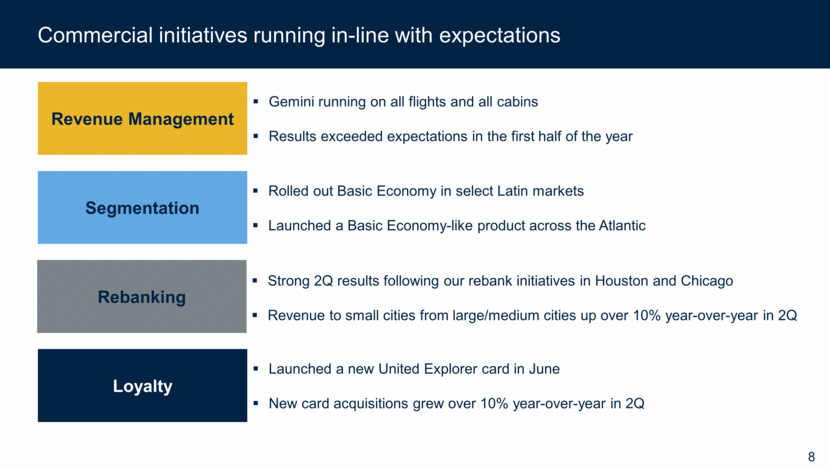
Financial Update

Adjusted debt1 2Q18 Debt, pension and post-retirement obligations ($B)2 United’s balance sheet is well positioned among peers 1 Adjusted debt and adjusted EBITDA are non-GAAP measures; adjusted EBITDA excludes special charges. For a GAAP to non-GAAP reconciliation, see Appendix A 2 Source: SEC filings for Delta Air Lines and American Airlines Group 3 Annual aircraft rent capitalized at 7x, see Appendix A United Leverage 2Q18 LTM Net Income ($B) $2.1 Adj. EBITDA1 ($B) $5.7 Debt / Adj. EBITDA1 3.1x Adj. Debt / Adj. EBITDA1 3.8x $21.7 +$18.0 $39.7 $21.6 Pension and post-retirement liability Debt and capital lease obligations Aircraft rent, capitalized3 Moody’s Fitch S&P Ba2 BB BB Upgraded January 2017 Upgraded October 2016 Upgraded April 2018 UAL credit ratings $14.5 $9.9 $24.1 $3.8 $2.6 $8.5 $3.4 $9.1 $7.1
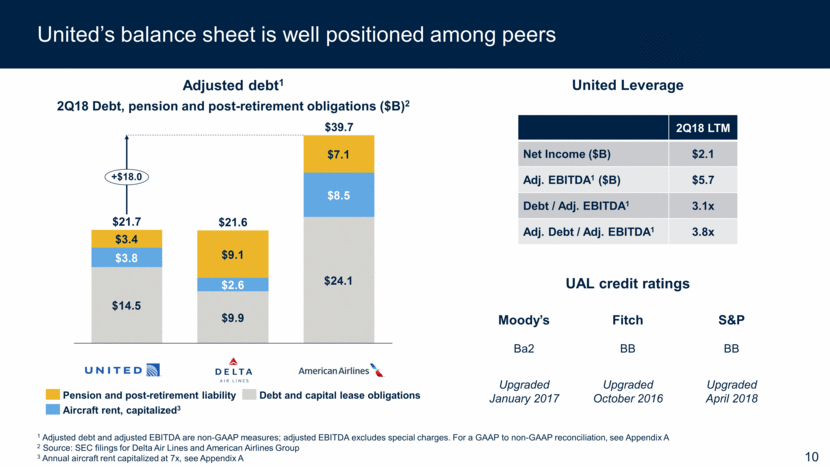
$5B - $6B is the optimal liquidity level Absorb seasonality of the business (~$1.5B peak to trough) Meets debt and capital expenditure commitments Provides sufficient liquidity under extreme stress-test (e.g. Sept. 11th) scenario Strong liquidity position Minimum target balance $5.0B YE17 $5.8 YE16 $5.8 $4.45 $1.35 2Q18 $7.1 Unrestricted liquidity ($B) Unrestricted cash and short-term investments Revolving credit facility Increased revolving credit facility to $2B in 1Q17 with the full amount undrawn as of June 30, 2018 $3.8 $5.1 $2.0 $2.0
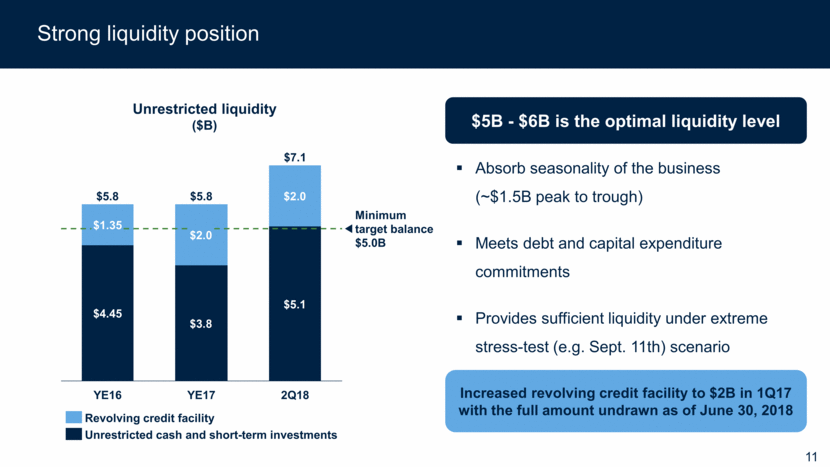
Capital allocation and fleet update Share Repurchases Repurchased ~$1B worth of shares in the first half of the year, representing ~5% of shares outstanding as of year-end 2017 ~$2.0B in repurchase authority remaining Plan to continue to opportunistically return cash to shareholders through share repurchases Fleet Announced new order for 9 Boeing 787 aircraft, with expected delivery starting in 2020 Purchasing 20 used Airbus A319 aircraft with expected delivery in 2020 and 2021 Pursuing additional used aircraft transactions to supplement new aircraft deliveries
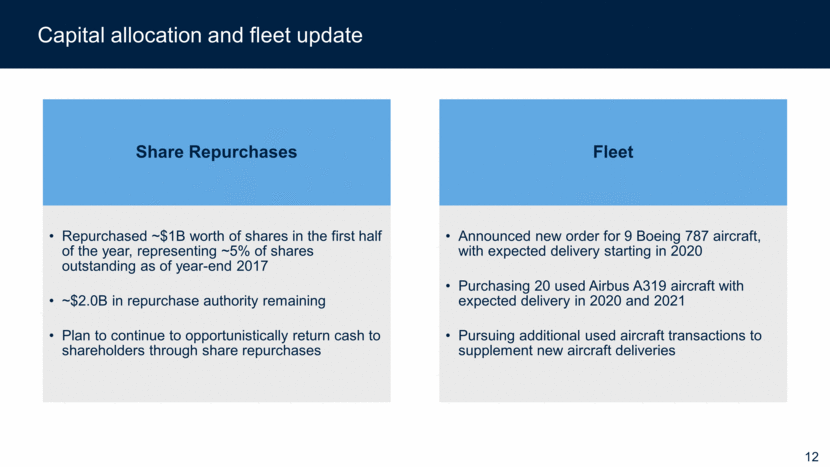
Capital expenditures in 2018 expected to be $3.6B - $3.8B 24 scheduled aircraft deliveries in 2018 Opportunistic purchases of aircraft off-lease Continue to invest in product, technology and infrastructure Adjusted capital expenditures ($B) $3.6 - $3.8 2017 ~($1.0) 2018E 1 Adjusted capital expenditures is a non-GAAP measure and excludes non-cash capital expenditures and fully reimbursable projects. For a GAAP to non-GAAP reconciliation, see Appendix A 2 Excludes non-cash capital expenditures and fully reimbursable projects, the amount and timing of which are not determinable at this time. Accordingly, the company is not providing capital expenditure guidance on a GAAP basis. Non-GAAP GAAP 1 2 $4.0 $4.7
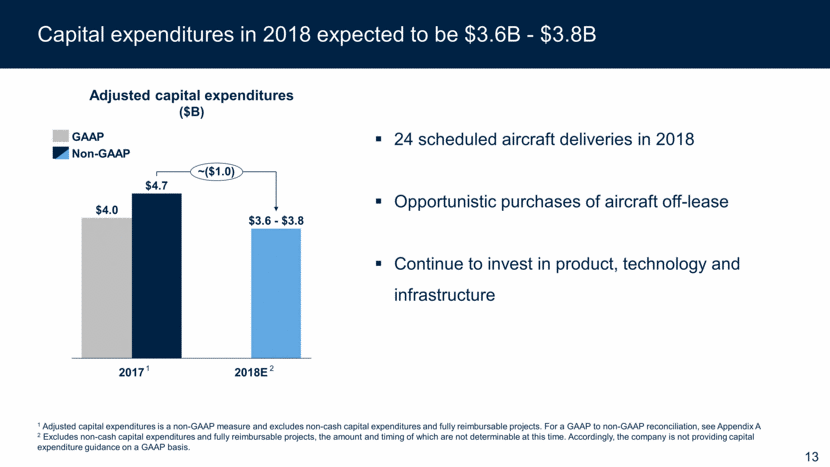
Reaching financial targets will guide our long term network strategy Primary focus areas: Strengthening and growing our domestic network Driving asset efficiency and productivity Target ~25% CAGR adj. EPS from 2018 through 2020 2020E $11.00 - $13.00 2018E 1Q Update $7.00 - $8.50 2018E Initial $6.50 - $8.50 2018E 2Q Update $7.25 - $8.75 Target adjusted earnings per share, diluted1 1 Excludes special charges and the impact of mark-to-market adjustments on equity investments, the nature of which are not determinable at this time. Accordingly, the company is not providing earnings guidance on a GAAP basis
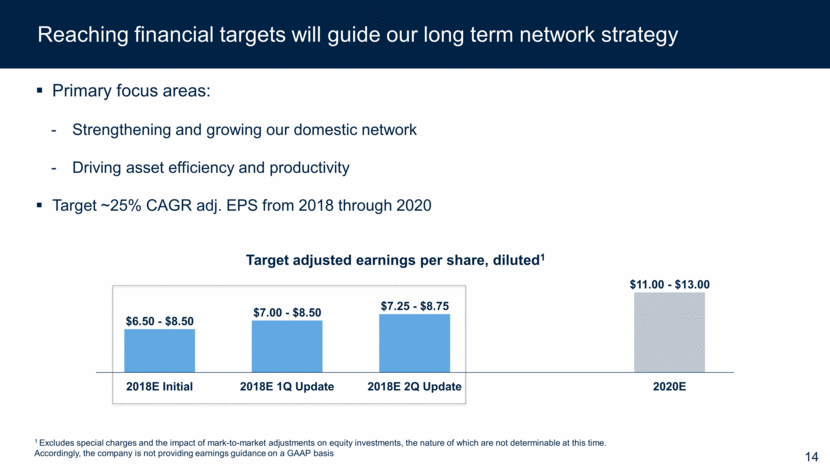
[LOGO]
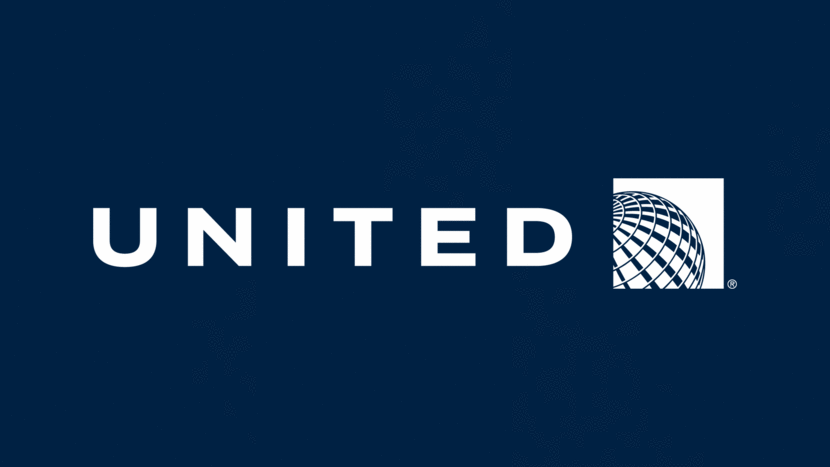
Appendix A: reconciliation of GAAP to Non-GAAP financial measures UAL evaluates its financial performance utilizing various accounting principles generally accepted in the United States of America (GAAP) and Non-GAAP financial measures. UAL provides financial metrics, including earnings before interest, taxes depreciation and amortization (EBITDA), excluding special charges and market-to-market losses on equity investments, and adjusted debt, that we believe provides useful supplemental information for management and investors. This financial metric is also adjusted for special items that management believes are not indicative of UAL’s ongoing performance. Aircraft rent is annualized and adjusted times seven per industry standards. 1 Amounts adjusted due to the adoption of Accounting Standards Update No. 2014-09, Revenue from Contracts with Customers (Topic 606) and Accounting Standards Update No. 2017-07, Improving the Presentation of Net Periodic Pension Cost and Net Periodic Postretirement Benefit Cost. For additional information related to adjustments, see the press release issued by UAL dated February 28, 2018, filed on that date with the SEC as an exhibit to UAL’s Form 8-K. 2 For additional information related to special charges. See Note 14 in Part II, Item 8 of United’s Annual Report on Form 10-K for fiscal year ended December 31, 2017 (In millions) EBITDA Twelve Months Ended June 30, 20181 Net income $2,055 Adjusted for: Depreciation and amortization 2,193 Interest expense 695 Interest capitalized (73) Interest income (75) Income tax expense 599 Special charges before income taxes2 250 MTM losses on equity investments 90 Adjusted EBITDA, excluding special charges and MTM losses on equity investments - Non-GAAP $5,734 (In millions) Adjusted Debt Quarter Ended June 30, 2018 Current maturities of long-term debt $887 Current maturities of capital leases 117 Long-term debt 12,460 Long-term obligations under capital leases 1,039 Postretirement benefit liability 1,585 Pension liability 1,815 Balance sheet debt 17,903 Aircraft rent at 7x 3,752 Adjusted debt - Non-GAAP $21,655
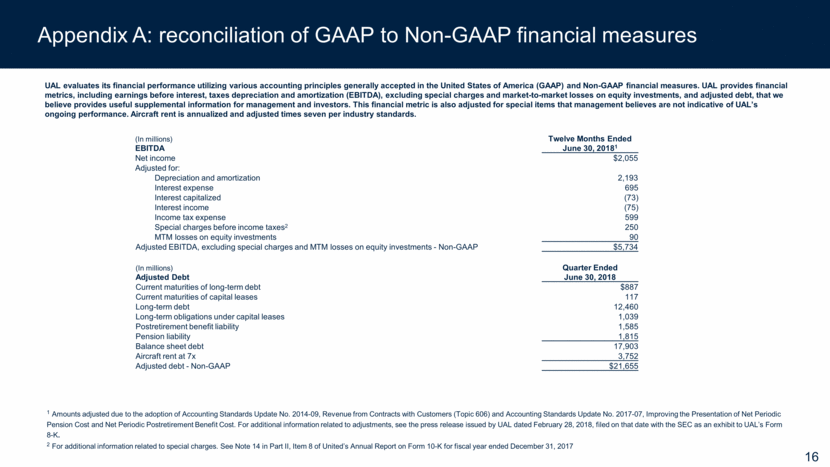
Appendix A: reconciliation of GAAP to Non-GAAP financial measures (continued) UAL believes that adjusting capital expenditures for assets acquired through the issuance of debt and capital leases, airport construction financing and excluding fully reimbursable projects is useful to investors in order to appropriately reflect the non-reimbursable funds spent on capital expenditures (In millions) Capital Expenditures Year Ended December 31, 2017 Capital expenditures $ 3,998 Property and equipment acquired through the issuance of debt and capital leases 935 Airport construction financing 42 Fully reimbursable projects (246 ) Adjusted capital expenditures – Non-GAAP $ 4,729
